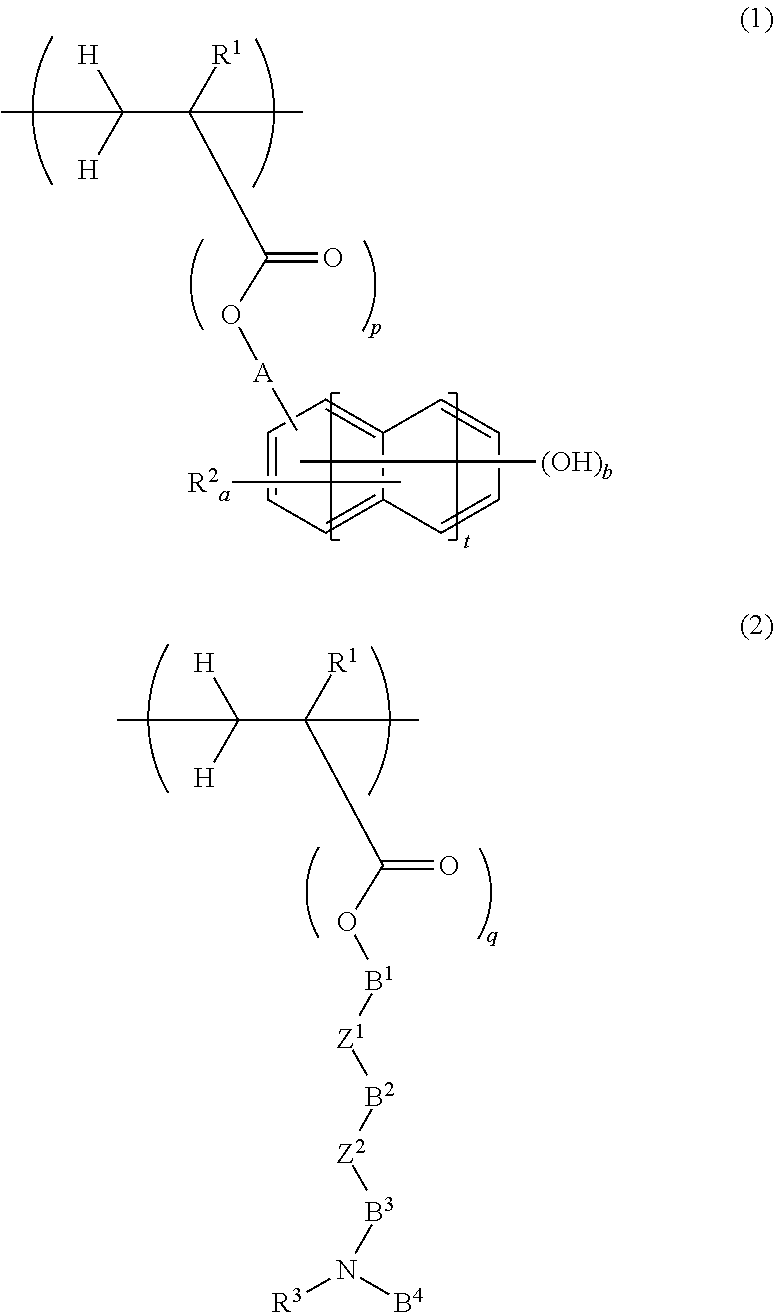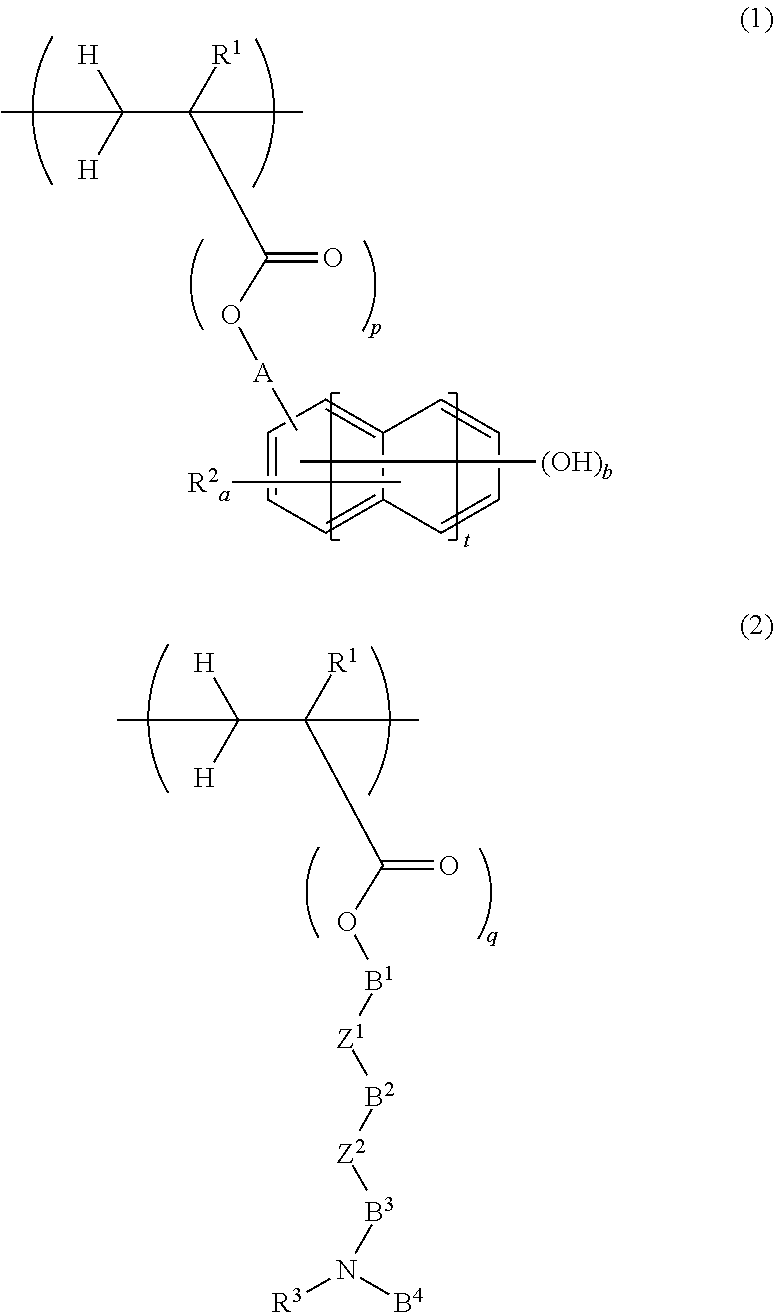Chemically amplified positive resist composition for EB or EUV lithography and patterning process
a technology of eb or euv lithography and composition, applied in the direction of photosensitive materials, instruments, photomechanical equipment, etc., can solve the problems of -dependent profile change, long scanning time, and variation detrimental to mask processing for forming fine size patterns, etc., to achieve less temperature dependence, improve ler, and high resolution
- Summary
- Abstract
- Description
- Claims
- Application Information
AI Technical Summary
Benefits of technology
Problems solved by technology
Method used
Image
Examples
polymer synthesis example 1
[0144]In a 200-mL dropping funnel under nitrogen blanket, a solution was prepared by dissolving 22.3 g of 4-hydroquinone monomethacrylate, 5.7 g of acenaphthylene, 21.4 g of 4-amyloxystyrene, 0.55 g of a monomer Z-1 of the structure shown below, and 5.1 g of dimethyl 2,2′-azobis(2-methyl-propionate) (V601, Wako Pure Chemical Industries, Ltd.) in 64 g of methyl ethyl ketone (MEK) as a solvent. A 300-mL polymerization flask was purged with nitrogen, charged with 53 g of MEK, and heated at 80° C., after which the solution was added dropwise to the flask over 4 hours. After the completion of dropwise addition, stirring was continued for 16 hours while maintaining the polymerization temperature of 80° C. The polymerization solution was then cooled down to room temperature and added dropwise to 1,000 g of hexane for precipitation. The copolymer precipitate was collected by filtration and washed twice with 200 g of hexane. The mass collected by filtration was dissolved in 120 g of MEK. The...
polymer synthesis example 2
[0146]In a 200-mL dropping funnel under nitrogen blanket, a solution was prepared by dissolving 25.6 g of 4-(1-ethoxyethoxy)styrene, 4.1 g of acenaphthylene, 19.8 g of 4-amyloxystyrene, 0.53 g of monomer Z-1 of the above structure, and 4.9 g of dimethyl 2,2′-azobis(2-methyl-propionate) (V601, Wako Pure Chemical Industries, Ltd.) in 64 g of propylene glycol monomethyl ether (PGME) as a solvent. A 300-mL polymerization flask was purged with nitrogen, charged with 53 g of PGME, and heated at 80° C., after which the solution was added dropwise to the flask over 4 hours. After the completion of dropwise addition, stirring was continued for 20 hours while maintaining the polymerization temperature of 80° C. Thereafter, the polymerization solution was cooled down to room temperature, combined with 18 g of methanol and 0.85 g of oxalic acid dihydrate, and stirred at 50° C. for 3 hours. The reaction solution was added dropwise to a mixture of 1,620 g of water and 30 g of methanol for precipi...
polymer synthesis example 3
[0147]A polymer was obtained by introducing hydroxystyrene units according to the same procedure as Polymer Synthesis Example 2 except that the type and amount of monomers were changed. The polymer was further reacted with 1-chloro-1-methoxy-2-methylpropane under basic conditions to produce an acetal-modified polymer, designated Polymer 3, having Mw=5,860 and Mw / Mn=1.65.
[0148]With respect to the deprotection and protection of polyhydroxystyrene derivative, reference may be made to Patent Documents 8 and 9.
Polymer Synthesis Examples 4 to 30
[0149]Resins (Polymers 4 to 30) shown in Table 1 were synthesized by the same procedure as Polymer Synthesis Example 1, 2 or 3 except that the type and amount of monomers were changed. The units 1 to 4 in Table 1 have the structure shown in Table 2. In Table 1, a ratio of each unit incorporated is on a molar basis.
[0150]
TABLE 1Unit 1Unit 2Unit 3Unit 4Resin(ratio)(ratio)(ratio)(ratio)Polymer 1A-1(0.45)B-1(0.41)D-2(0.13)Z-1(0.01)Polymer 2A-2(0.50)B-1...
PUM
| Property | Measurement | Unit |
|---|---|---|
| feature size | aaaaa | aaaaa |
| width | aaaaa | aaaaa |
| roughness | aaaaa | aaaaa |
Abstract
Description
Claims
Application Information
 Login to View More
Login to View More - R&D
- Intellectual Property
- Life Sciences
- Materials
- Tech Scout
- Unparalleled Data Quality
- Higher Quality Content
- 60% Fewer Hallucinations
Browse by: Latest US Patents, China's latest patents, Technical Efficacy Thesaurus, Application Domain, Technology Topic, Popular Technical Reports.
© 2025 PatSnap. All rights reserved.Legal|Privacy policy|Modern Slavery Act Transparency Statement|Sitemap|About US| Contact US: help@patsnap.com



